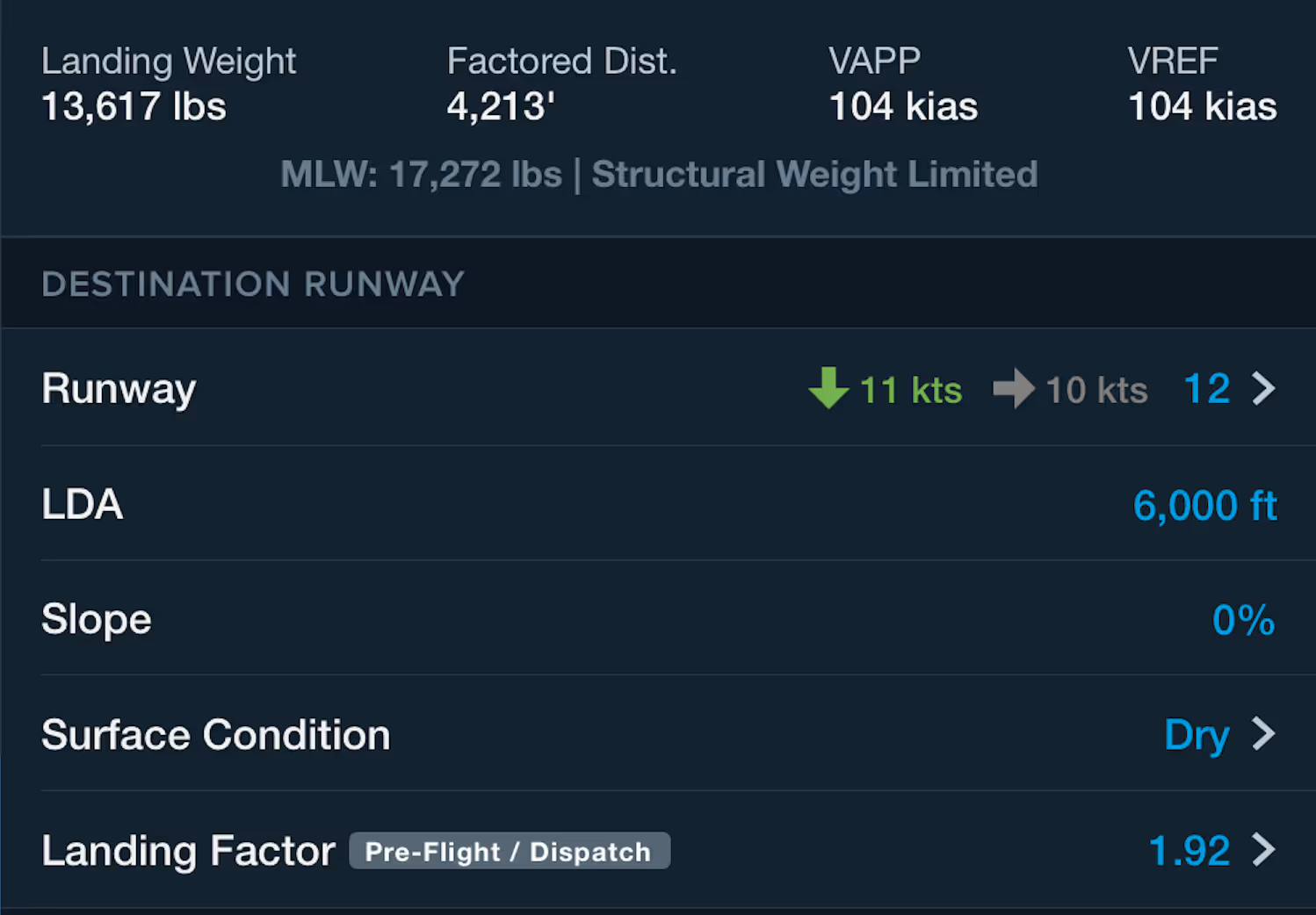Landing Distance Matters: How to Calculate It & Improve Runway Safety

Runway safety, particularly runway excursions, remains one of aviation's top safety concerns. Accidents caused by runway excursions are the most common aviation accident type, and the rate and number of occurrences worldwide have remained steady over the past decade.
The #1 Aviation Concern: Runway Safety
But, there is progress. The data shows that although the absolute number of accidents and incidents and the severity still indicate a very high risk, the number of runway excursion accidents involving aircraft operated by airlines has in fact reduced. However, in the corporate jet sector, runway excursion accidents remain particularly prevalent. According to the Flight Safety Foundation’s 2022 Safety Report, runway excursion accidents occurred 16 times between 2017-2022 in the airliner category, but 79 times in the corporate jet category - of which 66 were during the landing phase.
How to Mitigate Runway Excursions and Improve Runway Safety
So what can be done? In commercial aviation, improvements in runway excursion occurrences have followed the implementation of several measures to mitigate the risks of runway excursions. These include the introduction in 2021 of ICAO’s New Global Reporting Format for Runway Surface Conditions, additional pilot go-around training and tightening of standard operating procedures (SOPs) to ensure an aircraft is correctly positioned for a safe landing.
Airline SOPs specify stable approach criteria: at 1000ft flight crew are required to be on the correct approach profile, in the landing configuration and at the target speed. If not, a go-around must be performed. Similarly, if during the flare, it is obvious to the pilots the aircraft will not touchdown within the touchdown zone, a go-around must be performed.
Better decision-making is a training focus, facilitated by missed approach training in recurrent checks with an emphasis placed on the benefits of a more rule-based approach.
In airline operations, flight planners and pilots are obliged to comply with these regulations and are closely monitored. As a result, the sector is now experiencing a reduction in runway excursion accidents.
Business Aviation Strategies
Within business aviation, private operators may not have to comply with the same regulations as airlines. Still, efforts are similarly underway to reduce risks and improve runway safety, particularly on landing.
In its analysis of the corporate jet sector, the Foundation's findings focused on five categories (runway excursions, loss of control, gear-up/collapsed landing, ground damage and turbulence) which accounted for approximately 70 percent of the accidents during the six-year period under review.

Runway excursion accidents topped the list of accident types, with 79 occurrences—more than double the next highest known accident type, loss of control.
As a result of these findings, the FSF and Eurocontrol coordinated aviation professionals from more than 40 organizations to develop the Global Action Plan for the Prevention of Runway Excursions (GAPPRE), a comprehensive two-year plan to identify risks and implement mitigation measures to enhance runway safety validated by the Civil Air Navigation Services Organisation, the European Union Aviation Safety Agency and the International Air Transport Association, and supported by the European Business Aviation Association (EBAA) and the Federal Aviation Administration (FAA).
Precision Planning
So what are the measures? For aircraft operators, there are 35 risk mitigation proposals, including:
- Development and training on go-around standard operating procedures
- Defining what a stabilized approach looks like
- Training on EFB performance applications used for takeoff and landing performance calculations
In the US, the FAA recently updated AC 91-79B, Aircraft Landing Performance and Runway Excursion Mitigation. Like the GAPPRE, the AC stresses that pilots should calculate landing performance twice. Calculations should be based on AFM data, using expected conditions for landing at the ETA, and with relevant landing factors applied. The first calculations are made during pre-departure flight planning and then again in-flight, ideally before top-of-descent, as a time of arrival (TOA) landing distance assessment.
Calculating the Landing Distance: A Quick Formula Overview
The certified landing distance is comprised of three individual distances -- the air distance from a 50 ft height to main gear touchdown, the transition distance to derotate the aircraft, and the stopping distance to come to a complete stop. The AFM landing distance includes the three individual distances, and will define details, such as descent flight path angle used for the air distance, for example.
The in-flight landing distance calculation should allow for any actual runway surface conditions which affects braking action - an aircraft needs more stopping distance on a wet, snowy or icy runway than on a dry runway. Pilots can use the Runway Condition Code (RCC) reported by the airport ATIS, or derive an RCC from the Runway Condition Assessment Matrix (RCAM) based on the reported depth and type of runway contaminant.
These performance calculations are a necessary part of improving landing safety and mitigating runway excursion risks, yet are complex and time-consuming. Remember the need to calculate pre-departure landing performance for all required alternate airfields, too. Fortunately for corporate jet pilots, there are now sophisticated tools that can assist.
Flight planning software from ForeFlight makes the entire calculation process straightforward, fast and accurate. The ForeFlight Mobile app is increasingly used by business aviation operators for its runway analysis capabilities for takeoff and landing performance. The recently upgraded landing performance workflow supports both preflight and inflight landing distance calculations.
How to Make the Landing Distance Calculation Process Easier with ForeFlight
Let's consider a practical scenario to illustrate the application of landing performance assessment using information from ForeFlight Mobile.
Suppose a Part 135 flight is scheduled from San Antonio, TX (KSAT), to Miami Opa-Locka Executive (KOPF) using a Phenom 300E aircraft. The weather forecast at ETA indicates steady rain and an approach to runway 12 can be expected.

During preflight planning, the Landing Distance at Time of Arrival (LDTA) calculation reveals a required landing field length of 4213 ft, which includes the required 60% landing factor and a 15% safety margin for wet runway conditions. Given that the Landing Distance Available (LDA) on runway 12 exceeds the calculated 4213 ft, the flight can be dispatched with confidence using ForeFlight's precise landing performance analysis.
ForeFlight also allows operators to customize the displayed landing factors based on their specific operational requirements. By selecting the appropriate factors based on regulatory requirements, operational procedures, and reported runway conditions, operators can optimize landing performance assessments and enhance safety outcomes.
Effective landing performance assessment is paramount in mitigating the risk of runway excursions. ForeFlight’s Runway Analysis and Weight & Balance work together to continually calculate and validate data in the background, surface messages if limits are exceeded or critical data is missing, and quickly call attention to areas that need addressing.
Changes to any aspect of the flight plan trigger fast recalculations of performance data, allowing pilots to focus on other vital tasks instead of copying data between applications or manually adjusting for changing conditions.
And through the integrated flight releases between Dispatch and ForeFlight Mobile, both flight planners and pilots can collaboratively update Runway Analysis and Weight & Balance calculations in real-time.
Improving Runway Safety and Empowering Pilots
Ultimately, the decision to continue to land rests with the pilot. ForeFlight Mobile can’t fly the aircraft, nor make a landing decision. But what it does offer is a comprehensive tool to provide simple, fast and accurate runway analysis to help you make well-informed decisions for safe landings, every flight.
Learn more about ForeFlight’s Runway Analysis capabilities.
FAQs
Other than in the ATIS, where are runway condition codes (RCC or RwyCC) for landing distance calculations found?
RCC values for runways can be found as Field Condition (FICON) reports in NOTAMs in the US, in NOTAMs globally, and also in D-ATIS.
What role do weather conditions play in landing distance?
Weather conditions, especially wind and precipitation, play a significant role in an aircraft’s achievable landing distance. A tailwind component significantly increases both air and ground distances of the total landing distance. Runway surface conditions other than dry can significantly reduce the braking ability, leading to longer stopping distances.
What are the best practices for pilots to ensure safe landing distances?
A stable and on-speed approach to landing is critical to ensure the achieved landing distance does not significantly exceed the AFM distance. Once on the ground, immediate and purposeful use of braking devices such as brake application, spoilers and thrust reversers are key to ensuring a short stopping distance.






